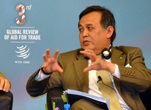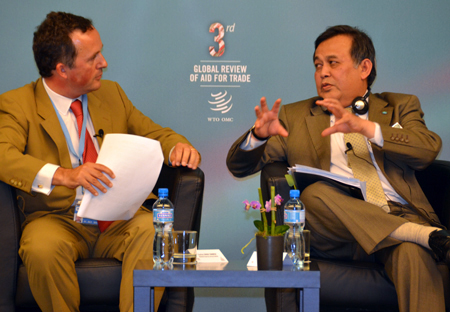APEC weighs in on WTO’s Third Global Review of Aid for Trade


Photo courtesy of the World Trade Organization
Making it easier for businesses to deal with non-tariff barriers will contribute to economic expansion, said APEC Secretariat Executive Director, Ambassador Muhamad Noor, at the Third Global Review of Aid for Trade in Geneva on Monday.
The World Trade Organization (WTO), its members and key international aid and development organizations are conducting the Third Global Review of Aid for Trade from 18-19 July in Geneva. Aid for Trade is an initiative aimed at helping developing and least-developed countries to increase exports of goods and services, to integrate more effectively into the multilateral trading system and to benefit from liberalized trade and increased market access opportunities.
During a session on trade facilitation, Ambassador Noor offered an assessment of APEC’s achievements since the launch of the initiative and offered lessons about the impact of APEC’s work in the area.
“Preliminary estimates suggest that APEC’s work on trade facilitation reduced business transaction costs within APEC by 5.2 percent in real terms during the 2007-2010 period – representing a net savings of around US$60 billion.”
“APEC’s Trade Facilitation Action Plans greatly contribute towards the realisation of free trade and investment in the Asia Pacific region,” he said in a reference to the Bogor Goals.
He said that following the reduction in tariffs as a result of trade negotiations and unilateral liberalisation, non-tariff issues, including customs and other procedures, have become relatively more significant to the effort to promote trade.
“In recent years there has been a globalisation of the supply chain with multiple economies being involved in the production of many goods,” explained Noor. “There is increasing need for trade facilitation efforts, more so on behalf of small and medium size businesses.”
On average, APEC funds around 100 projects each year, to a total value of about US$8 million.
“For APEC, which operates under a voluntary framework, capacity building is even more critical to the implementation effort,” Noor underscored.
In 2010, 18 percent of APEC’s funding for capacity building was channeled to economic infrastructure; 38 percent went to APEC’s trade-related capacity building including support for reforms in banking and financial services; and 44 percent went to improving trade policy and regulation.
APEC economies’ total trade in goods and services increased five-fold between 1989 and 2010, from US$3.1 trillion to US$16.8 trillion and average tariffs in the region has fallen from 17 percent in 1989, to 6.2 percent in 2009.
Employment in APEC economies grew by 14 percent between 1996 and 2009 while poverty was reduced by 42 percent between 1994 and 2007, according to the APEC Policy Support Unit.
# # #
For more information, contact: Ai Ghee Ong +65 6891 9671 at [email protected] or Michael Chapnick +65 6891 9670 at [email protected]
Details about APEC meetings, events, projects and publications can be found at www.apec.org or www.apec2011.gov. You can also follow APEC on Twitter and join us on Facebook.

